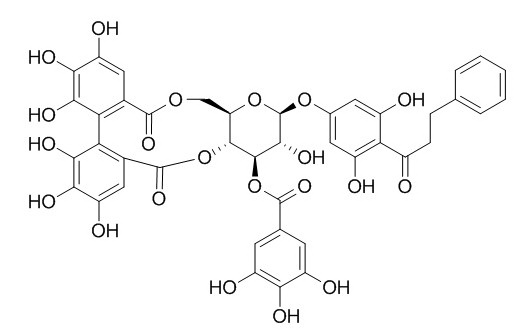Thonningianin A
Thonningianin A represents a new potent glutathione S-transferase in vitro inhibitor. Thonningianin A has anti-cancer and antioxidant properties, involves radical scavenging, anti-superoxide formation and metal chelation.
Inquire / Order:
manager@chemfaces.com
Technical Inquiries:
service@chemfaces.com
Tel:
+86-27-84237783
Fax:
+86-27-84254680
Address:
1 Building, No. 83, CheCheng Rd., Wuhan Economic and Technological Development Zone, Wuhan, Hubei 430056, PRC
Providing storage is as stated on the product vial and the vial is kept tightly sealed, the product can be stored for up to
24 months(2-8C).
Wherever possible, you should prepare and use solutions on the same day. However, if you need to make up stock solutions in advance, we recommend that you store the solution as aliquots in tightly sealed vials at -20C. Generally, these will be useable for up to two weeks. Before use, and prior to opening the vial we recommend that you allow your product to equilibrate to room temperature for at least 1 hour.
Need more advice on solubility, usage and handling? Please email to: service@chemfaces.com
The packaging of the product may have turned upside down during transportation, resulting in the natural compounds adhering to the neck or cap of the vial. take the vial out of its packaging and gently shake to let the compounds fall to the bottom of the vial. for liquid products, centrifuge at 200-500 RPM to gather the liquid at the bottom of the vial. try to avoid loss or contamination during handling.
J of the Society of Cosmetic Scientists of Korea2018, 44(4):407-417
Chem Biodivers.2023, 20(12):e202301461.
Appl. Sci.2021, 11(19),9343.
Molecules.2023, 28(8):3503.
J Ethnopharmacol.2023, 321:117501.
J Sep Sci.2021, 44(22):4064-4081.
Anat Rec2018, 24264
Biol Pharm Bull.2018, 41(1):65-72
Phytomedicine.2024, 126:155442.
Allergol Immunopathol (Madr).2022, 1;50(4):23-30.
Related and Featured Products
Food Funct. 2015 Aug;6(8):2588-97.
Effects of thonningianin A in natural foods on apoptosis and cell cycle arrest of HepG-2 human hepatocellular carcinoma cells.[Pubmed:
26119846]
METHODS AND RESULTS:
The anti-cancer activities of Thonningianin A on the HepG-2 human hepatocellular carcinoma cell line were evaluated by MTT assay, flow cytometry, quantitative real-time PCR and western blotting. Results showed that Thonningianin A effectively inhibited the proliferation of HepG-2 cells by inducing apoptosis, as evidenced by increase in the sub-G1 cell population, DNA fragmentation, and increase in the content of reactive oxygen species. Activation of caspase-9 and the subsequent activation of caspase-3 indicated that Thonningianin A-induced apoptosis is caspase-dependent. Thonningianin A also disrupted the mitochondrial membrane potential (Δψm) and down-regulated the Bcl-xL mRNA expression in HepG-2 cells. Thonningianin A induced cell cycle arrest by changing the cyclin D1 and CDK4 mRNA expression levels. Moreover, western blotting showed that Thonningianin A significantly down-regulated the NF-kappa-B cell survival pathway, along with up-regulation of the expression level of phosphorylated P38 and down-regulation of the expression level of phosphorylated ERK.
CONCLUSIONS:
The anti-cancer activity of Thonningianin A was confirmed by the characteristic patterns of DNA fragmentation and cell cycle arrest, suggesting that Th A is an effective antitumor ingredient in natural plant foods, and is worthy of further study.
Biochem Pharmacol. 2002 May 1;63(9):1725-37.
Antioxidant properties of Thonningianin A, isolated from the African medicinal herb, Thonningia sanguinea.[Pubmed:
12007576]
The antioxidant properties of Thonningianin A (Th A), an ellagitannin, isolated from the methanolic extract of the African medicinal herb, Thonningia sanguinea were studied using the NADPH and Fe2+/ascorbate-induced lipid peroxidation (LPO), electron spin resonance spectrometer and the deoxyribose assay.
METHODS AND RESULTS:
Thonningianin A at 10 microM inhibited both the NADPH and Fe2+/ascorbate-induced LPO in rat liver microsomes by 60% without inhibitory effects on cytochrome P450 activity. Thonningianin A was similar to the synthetic antioxidant, tannic acid, as an inhibitor of both the NADPH and Fe2+/ascorbate-induced LPO but potent than gallic acid, vitamin C and vitamin E. While Thonningianin A poorly scavenged the hydroxyl radical generated by the Fenton reaction it dose-dependently scavenged 1,1-diphenyl-2-picrylhydrazyl, superoxide anion and peroxyl radicals with IC50 of 7.5, 10 and 30 microM, respectively. Furthermore, Thonningianin A showed inhibitory effects on the activity of xanthine oxidase with an IC50 of 30 microM. In the deoxyribose assay both T. sanguinea and its methanolic component Thonningianin A showed only site-specific (Fe3+ + H2O2) but not non-site-specific (Fe3+ + EDTA + H2O2) hydroxyl radical scavenging suggesting chelating ability for iron ions.
CONCLUSIONS:
Spectroscopic studies showed that Thonningianin A enhanced absorbance in the visible region in the presence of Fe2+ ions.
These results indicate that the antioxidant properties of Thonningianin A involve radical scavenging, anti-superoxide formation and metal chelation.
Food Chem Toxicol. 2004 Sep;42(9):1401-8.
Inhibition of glutathione S-transferases by thonningianin A, isolated from the African medicinal herb, Thonningia sanguinea, in vitro.[Pubmed:
15234070]
There is evidence that increased expression of glutathione S-transferase (EC: 2.5.1.18, GST) is involved in resistance of tumor cells against chemotherapeutic agents. In this study we investigated the inhibitory effects of Thonningianin A (Th A), a novel antioxidant isolated from the medicinal herb, Thonningia sanguinea on uncharacterized rat liver GST and human GST P1-1.
METHODS AND RESULTS:
Using 1-chloro-2,4-dinitrobenzene (CDNB) as substrate, rat liver cytosolic GST activity was inhibited by Thonningianin A in a concentration dependent manner with 50% inhibition concentration (IC50) of 1.1 microM. When Thonningianin A was compared with known potent GST inhibitors the order of inhibition was tannic acid>cibacron blue>hematin>Th A>ethacrynic acid with CDNB as substrate. Thonningianin A also exhibited non-competitive inhibition towards both CDNB and glutathione. Furthermore, using 1,2-dichloro-4-nitrobenzene, ethacrynic acid and 1,2-epoxy-3-(p-nitrophenoxy) propane as substrates Thonningianin A at 1.0 microM inhibited cytosolic GST by 2%, 12% and 36% respectively. Human GST P1-1 was also inhibited by Thonningianin A with an IC50 of 3.6 microM.
CONCLUSIONS:
While Thonningianin A showed competitive inhibition towards CDNB it exhibited non-competitive inhibition towards GSH of the human GST P1-1. These results suggest that Thonningianin A represents a new potent GST in vitro inhibitor.



